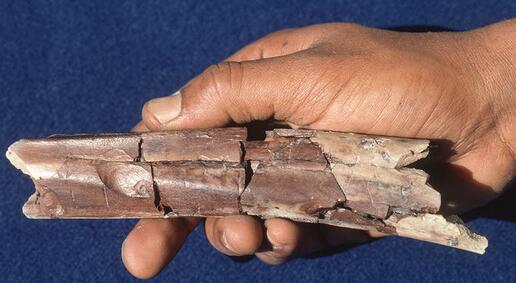Ancient animal and human bone cuts could be the work of crocodile teeth instead of early butchers
From:Science Magzine NetWriter:Michael PriceDate:2017-11-10
Scrapes and grooves, supposedly cut into fossil bones by early human ancestors, are nearly indistinguishable from marks left by crocodiles’ gnashing teeth, according to a new study. The finding casts doubt on a notable 2010 study that used the bone marks as evidence for stone tool use among some of our earliest evolutionary cousins.“I think basically everyone in zooarchaeology knows there’s a problem with cutmarks,” says David Braun, a paleoanthropologist at George Washington University in Washington, D.C., who wasn’t involved in the study. “Right now we don’t have a good system for knowing when we’re wrong.”

Marks on a 2.5-million-year-old ungulate may be the work of crocodiles, rather than butchery by human ancestors.
Now, however, a trio of paleoanthropologists—Yonatan Sahle and Sireen El Zaatari of the University of Tübingen in Germany and Tim White of the University of California, Berkeley—have shown that crocodile teeth can also leave V-shaped cuts in mammal bones that are indistinguishable from stone-tool cuts.
To start, the trio butchered a sheep carcass with sharp stone flakes and found that the cutmarks indeed resembled those found on two different Australopithecine fossil arm bones—one dating to 4.2 million years ago and the other to 3.4 million years ago—as well as 2.5-million-year-old animal bones discovered near the known stone tools in the Olduvai Gorge. But then they looked at tooth marks from previous experiments in which researchers had captive crocodiles chomp down on sheep bones. The researchers used a high-powered microscope to compare all the different cutmarks.
In most cases, the cuts were totally indistinguishable from one another, the researchers report today in the Proceedings of the National Academy of Sciences. “The resemblance is so stunning,” Sahle says in an email. “There is no way you can tell whether this was produced by a croc tooth or a stone tool.” The authors note that many Australopithecus fossils have been found at sites that would have been swampy millions of years ago, and indeed fossilized crocodile bones have been found alongside the hominid remains. They argue that it’s a “dubious proposition” to put forth fossil bone cutmarks as the primary evidence for early stone tool use.
Yet other paleoanthropologists say the picture is even more complex than crocs versus tools. Manuel Domínguez-Rodrigo, a paleoanthropologist at the Complutense University of Madrid, says that in his own analysis of the Dikika bones, he found micro-abrasions along the bones’ surface and intersecting striations within grooves, textures that suggest neither crocodile bites nor stone-tool cuts, but instead damage by animal trampling. “If we consider not just shape and striation, but other variables as well, we can distinguish 80% to 90%, in some cases 100%, of the marks,” he says.
Curtis Marean, a paleoanthropologist at Arizona State University’s Institute of Human Origins in Tempe, and a co-author on the 2010 paper, and his graduate student Jacob Harris, say in an email to Science that “a reassignment of agency based on nothing more than another look by the experts is not appropriate”. They want to move toward a model-based system that assigns probabilities to the various origin stories based on all the data.
Braun adds that even incorrect assumptions can help advance the science. Paleoanthropologists know a lot more about cutmarks now than they did 20 years ago precisely because bold claims about Australopithecine butchers thrust the research into the spotlight, he says. The tension between wanting to advance a surprising new theory and wanting to eliminate all uncertainty from it, Braun says, is “a struggle at the soul of paleoanthropology.”

